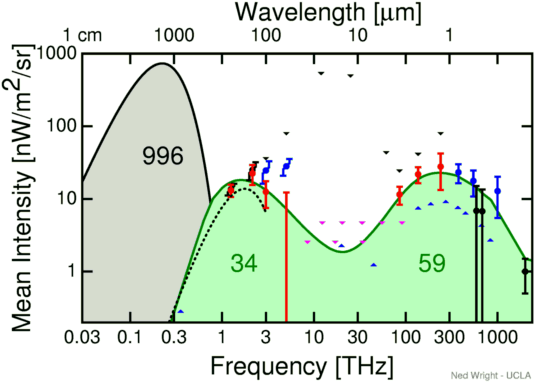
The Cosmic InfraRed Background (CIRB) is the radiation from stars in
many faint galaxies. It is what is left over after emission from our
Solar System and our Galaxy has been subtracted away.
Here are pictures of the sky before and after
this foreground subtraction.
The near-infrared (wavelengths near 2-3 microns) and optical (wavelengths
near 500 nm) part of this extragalactic background light is just
starlight redshifted into the infrared.
But some starlight is absorbed
by dust and re-emitted in the far-infrared (wavelengths near 100
microns). The figure below shows the cosmic near-infrared background
in red in the center right, Rebecca Bernstein's optical cosmic background
in blue on the far right, my recomputation of the far infrared background
in red in the center left, the
FDS
60 and 100 micron values in blue,
the cosmic microwave background in gray on the far left.

The black data points between 1 and 300 microns
on this graph come from the DIRBE experiment on
the COBE
satellite. The red data points are my modified and new DIRBE
results which use a different zodiacal light model than the one used by
Hauser et al. (1998, ApJ, 508, 25).
The blue lower limit symbols are based on integrating galaxy counts, while
the purple upper limit symbols are based on limits on photon-photon
collisions from gamma-ray astronomy.
The black data points at wavelengths shorter than 1 microns come
from
Dube, Wickes & Wilkinson (1979, ApJ, 232, 333),
Toller (1983, ApJL, 266, 79), and
Hurwitz, Martin & Bowyer (1991, ApJ, 372, 167).
The curve is the Lambda CDM model with the Salpeter IMF from
Primack et al.,
multiplied by a factor of 1.84, and with
modifications for wavelengths longer than 300 microns to fit the FIRAS
distortion limits, and for wavelengths shorter than 0.8 microns to fit the
optical and UV data.
Tutorial:
Part 1 |
Part 2 |
Part 3 |
Part 4
FAQ |
Age |
Distances |
Bibliography |
Relativity
© 1999-2001 Edward L. Wright. Last modified 4 Oct 2001